
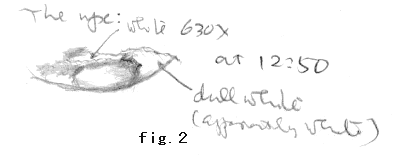


Figure 1 reproduces here his drawing made ten days later on 6 Mar (087deg Ls) at LCM=300deg W where Chasma Boreale was apparent again as well as the western end of Olympia in the evening.
Figure 2 is a rough and partial sketch of the north polar region made by the present writer (Mn) in the Observing Note of a drawing (Mn-404D) on 20 Mar (093deg Ls) at LCM=137deg W where the eastern end of Olympia was caught and the much morning area was slightly hazed.
Similarly Toshiaki HIKI (Hk) observed the morning Olympia on the same day at LCM=149deg W, and Masami MURAKAMI (Mk) at LCM=152deg W. Among several overseas observers, Sam WHITBY (SWb) detected Olympia clearly in the outskirts of the npc at LCM=161deg W on 8 April (101deg Ls) by use of W21. We hear from Mk that Don PARKER (DPk) shot the same aspect on 7 April, but his observation is not filed by us yet.
Many Japanese observers detected Olympia when the planet was near at opposition as a detachment to the very south of the npc at around LCM=200deg W. On 17 Mar, it was observed by Tomio AKUTSU (Ak) at LCM=197deg W by CCD (R), on 18 Mar visually by Mk at LCM=198deg W, on 20 Mar by Mn at LCM=183deg W etc, by Takashi NAKAJIMA (Nj) at LCM=188deg W etc and by Kunihiko OKANO (Ok) at LCM=196deg W (CCD in R) and on 22 Mar by Yukio MORITA (Mo) at LCM=191deg W (CCD in R) and so on.
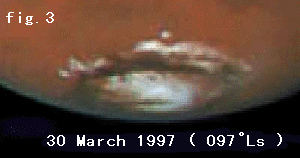 Figure 3 so shows the HST image of Olympia seen from around LCM=200deg W on 30 Mar 1997 (097deg Ls): The white spot near the CM is the Korolev crater located at (196deg W, 73deg N).
Figure 3 so shows the HST image of Olympia seen from around LCM=200deg W on 30 Mar 1997 (097deg Ls): The white spot near the CM is the Korolev crater located at (196deg W, 73deg N).
The image in Fig 3 proves if seen in colour that one third of the npc at the morning side is more faded in a tint of ocher. This was anticipated in
CMO #185
p2003 where it was stated that one fourth of the npc looked faded already on 10 Feb (076deg Ls):
Fig 3: HST image around at LCM=200deg W on 30 Mar (097deg Ls) 1997
The HST image on 10 Mar (089deg Ls) shows this more clearly, while there must be a problem of unstable calibration to the extent that since HST found out a dust streak inside the npc at 011deg Ls on 18 Sept 1996 they tended to use less Blue light to make the details clear inside the npc until the HST image on 30 Mar 1997 proved the abundance of water vapour on the summer hemisphere (cited in #191 p2102).
We next show as Fig 4 the HST image of the npc taken on 17 May 1997 at 119deg Ls from LCM=285deg W which is comparable with the HST one at 8 Apr 1995 (082deg Ls) at LCM=282deg W cited in #177. Figure 4 is from the B image cited in #200 p2234. To further compare, we cite as Fig 5 a bird-eye view of the npc made from the images taken by Mariner 9 and Viking Orbiters whose top is directed to LCM=270deg W. This is the same map that we cited in #177 p1872. We easily see that no rift to be called Rima Tenuis is visible.
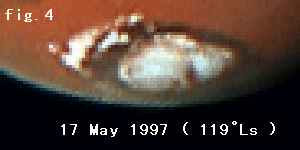
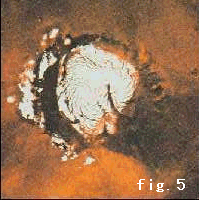
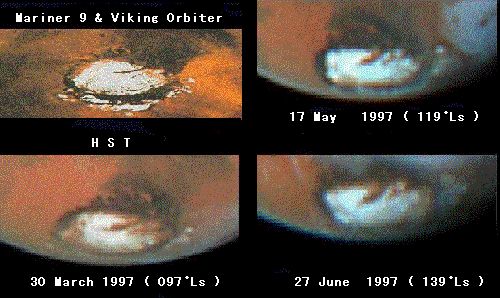 Finally we show a sequence of the HST npc in 1997 seen near from LCM=000deg W (Fig 6, prepared by Mk). The upper left image is the same with Fig 5 but rotated by 90 degrees and changed aspect ratio so that the top is directed to LCM=000deg W from which side it is difficult to see Olympia. The B light was fully used in May and the npc area looks as if more snowed, but note that
the HST's B image taken on 12 Sept 1997 at 180deg Ls does not show well the npc (cf #200 p2236).
Finally we show a sequence of the HST npc in 1997 seen near from LCM=000deg W (Fig 6, prepared by Mk). The upper left image is the same with Fig 5 but rotated by 90 degrees and changed aspect ratio so that the top is directed to LCM=000deg W from which side it is difficult to see Olympia. The B light was fully used in May and the npc area looks as if more snowed, but note that
the HST's B image taken on 12 Sept 1997 at 180deg Ls does not show well the npc (cf #200 p2236).